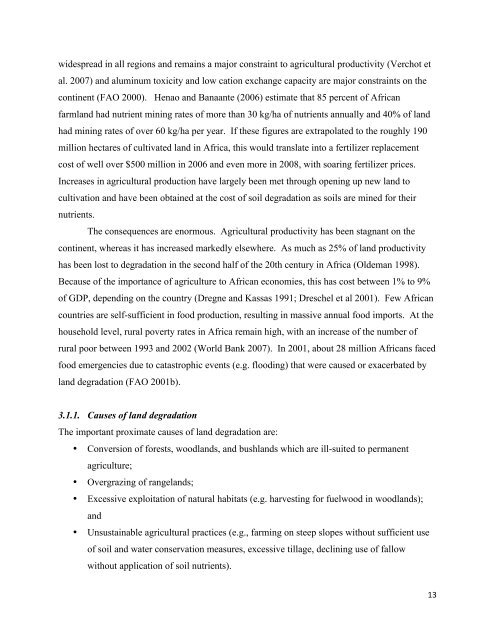The Role of Sustainable Land Management for Climate ... - CAADP
The Role of Sustainable Land Management for Climate ... - CAADP
The Role of Sustainable Land Management for Climate ... - CAADP
Create successful ePaper yourself
Turn your PDF publications into a flip-book with our unique Google optimized e-Paper software.
!<br />
widespread in all regions and remains a major constraint to agricultural productivity (Verchot et<br />
al. 2007) and aluminum toxicity and low cation exchange capacity are major constraints on the<br />
continent (FAO 2000). Henao and Banaante (2006) estimate that 85 percent <strong>of</strong> African<br />
farmland had nutrient mining rates <strong>of</strong> more than 30 kg/ha <strong>of</strong> nutrients annually and 40% <strong>of</strong> land<br />
had mining rates <strong>of</strong> over 60 kg/ha per year. If these figures are extrapolated to the roughly 190<br />
million hectares <strong>of</strong> cultivated land in Africa, this would translate into a fertilizer replacement<br />
cost <strong>of</strong> well over $500 million in 2006 and even more in 2008, with soaring fertilizer prices.<br />
Increases in agricultural production have largely been met through opening up new land to<br />
cultivation and have been obtained at the cost <strong>of</strong> soil degradation as soils are mined <strong>for</strong> their<br />
nutrients.<br />
<strong>The</strong> consequences are enormous. Agricultural productivity has been stagnant on the<br />
continent, whereas it has increased markedly elsewhere. As much as 25% <strong>of</strong> land productivity<br />
has been lost to degradation in the second half <strong>of</strong> the 20th century in Africa (Oldeman 1998).<br />
Because <strong>of</strong> the importance <strong>of</strong> agriculture to African economies, this has cost between 1% to 9%<br />
<strong>of</strong> GDP, depending on the country (Dregne and Kassas 1991; Dreschel et al 2001). Few African<br />
countries are self-sufficient in food production, resulting in massive annual food imports. At the<br />
household level, rural poverty rates in Africa remain high, with an increase <strong>of</strong> the number <strong>of</strong><br />
rural poor between 1993 and 2002 (World Bank 2007). In 2001, about 28 million Africans faced<br />
food emergencies due to catastrophic events (e.g. flooding) that were caused or exacerbated by<br />
land degradation (FAO 2001b).<br />
3.1.1. Causes <strong>of</strong> land degradation<br />
<strong>The</strong> important proximate causes <strong>of</strong> land degradation are:<br />
• Conversion <strong>of</strong> <strong>for</strong>ests, woodlands, and bushlands which are ill-suited to permanent<br />
agriculture;<br />
• Overgrazing <strong>of</strong> rangelands;<br />
• Excessive exploitation <strong>of</strong> natural habitats (e.g. harvesting <strong>for</strong> fuelwood in woodlands);<br />
and<br />
• Unsustainable agricultural practices (e.g., farming on steep slopes without sufficient use<br />
<strong>of</strong> soil and water conservation measures, excessive tillage, declining use <strong>of</strong> fallow<br />
without application <strong>of</strong> soil nutrients).<br />
!<br />
$&!

















